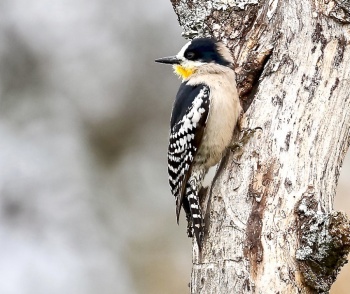- Melanerpes cactorum
Identification
16–18 cm (6¼-7¾ in)
Male:
- White forehead and forecrown and lores
- Yellow throat
- Black upperparts
- White underparts
Distribution
Southeast Peru, Bolivia, Brazil, Argentina, Paraguay and Uruguay.
Taxonomy
This is a monotypic species[1].
Habitat
Dry forests, forest edges, savanna, gallery forests, montane scrub and bush country
Behaviour
Breeding
They drill holes in the trunks and branches of Prosopis flexuosa and feeds on the exuded sap. They appear to nest in loose colonies.
Diet
They feed on insects, particularly ants; also beetles, with the addition of fruit. They have been observed predating on the egg of an Eared Dove.
References
- Clements, J. F., T. S. Schulenberg, M. J. Iliff, S. M. Billerman, T. A. Fredericks, B. L. Sullivan, and C. L. Wood. 2019. The eBird/Clements Checklist of Birds of the World: v2019. Downloaded from http://www.birds.cornell.edu/clementschecklist/download/
- Winkler, H., Christie, D.A. & Bonan, A. (2020). White-fronted Woodpecker (Melanerpes cactorum). In: del Hoyo, J., Elliott, A., Sargatal, J., Christie, D.A. & de Juana, E. (eds.). Handbook of the Birds of the World Alive. Lynx Edicions, Barcelona. (retrieved from https://www.hbw.com/node/56164 on 12 January 2020).
Recommended Citation
- BirdForum Opus contributors. (2025) White-fronted Woodpecker. In: BirdForum, the forum for wild birds and birding. Retrieved 4 April 2025 from https://www.birdforum.net/opus/White-fronted_Woodpecker
External Links
GSearch checked for 2020 platform.1





